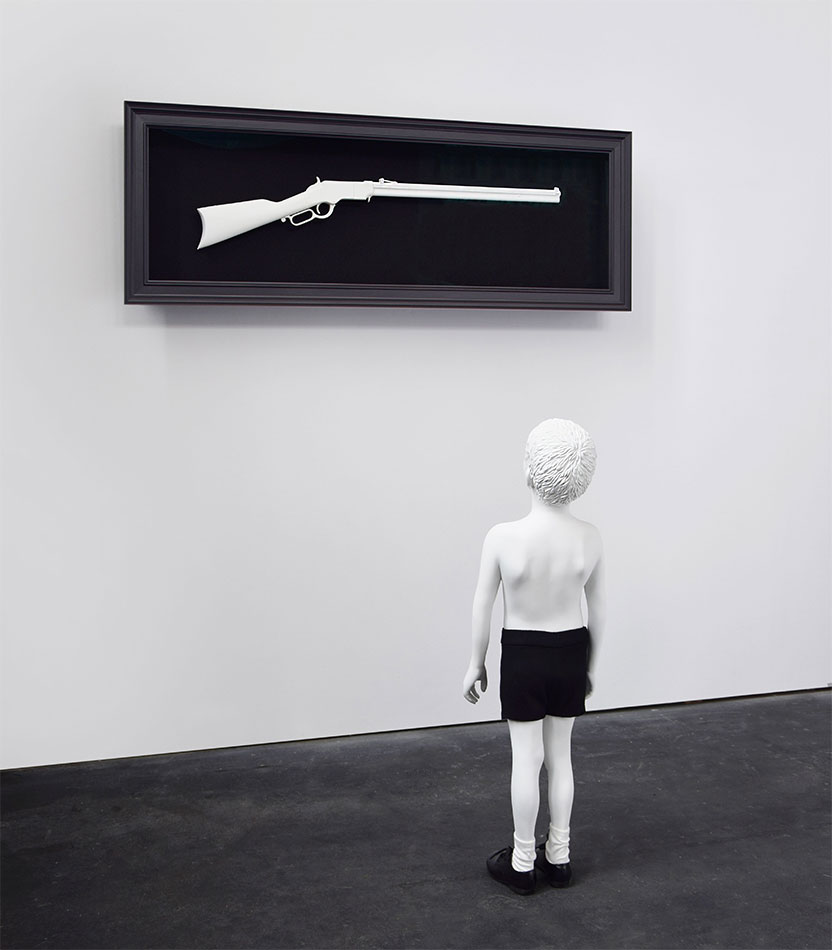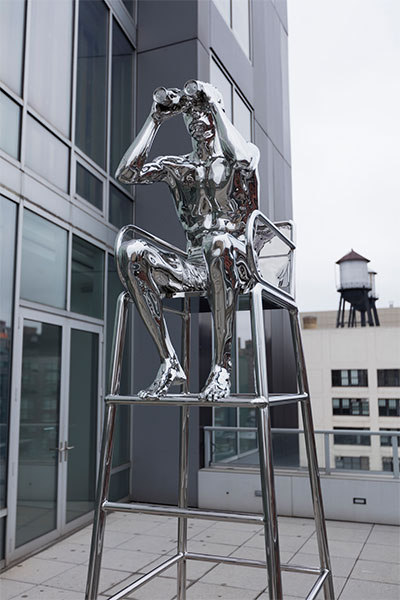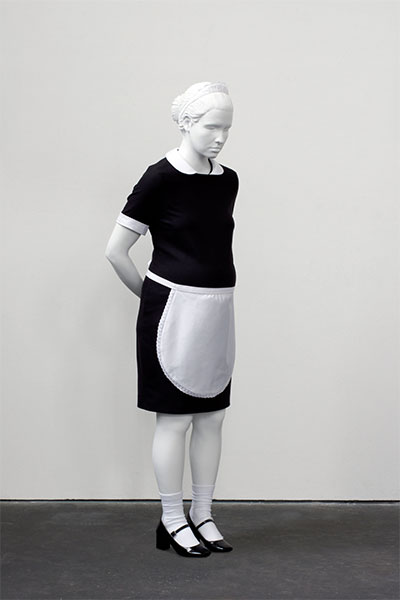
One Day, 2015
Aluminium, lacquer, glass, wood, fabric, clothes
Boy: 104 x 40 x 40 cm; vitrine: 55 x 145 x 20 cm
Courtesy of the artists. Photo by Holger Honck.
Whether it’s creating a faux art fair or turning a giant swimming pool on its Vincent-Van-Gogh’s-ear, two international artists are bringing their conceptual sculptural sensibilities to Dallas.
The Nasher Sculpture Center presents Elmgreen & Dragset: Sculptures, the artists’ first major U.S. museum exhibition, on view Sept. 14 through Jan. 5, 2020. True to form, Michael Elmgreen and Ingar Dragset have taken into consideration how their works relate to site—in this case, the unique focus of the Nasher and the multi-faceted nature of sculpture itself. And while they have had numerous solo shows in the UK, the artists say they are looking forward to learning how fresh connotations and understandings of their sculptures arise specific to Texas.
For more than 20 years, their collaborative practice has been informed by their different backgrounds: Elmgreen from poetry, Dragset from theater; their earliest formative artworks were performances in the mid-1990s in Copenhagen. They describe the city’s art scene as small and not so internationally-oriented. “There were only a few galleries dealing with contemporary art by younger artists and it felt quite isolated from the wider, global artistic landscape,” they say. “We’ve never been good at being part of a ‘scene’ though, and as a result, we began an ongoing personal exchange—one that has now continued over two decades.”

Watching
2016
Mirror-polished stainless steel
320 x 100.2 x 84.9 cm
Courtesy: Galerie Perrotin
Photo by: Steven Probert
Artist-run spaces provided opportunities to experiment freely without restraint from commercial pressures. They also cite moving to Berlin in 1997, where they currently live and work, as a significant event in their progression as artists. “It provided us with the opportunity to […] practice on our own terms in a new city where there were still no fixed parameters or any established structures set after the fall of the Berlin wall.”
Back in Dallas, the Nasher exhibition focuses on the pair’s sculptural practice, as opposed to a focus on a singular installation, showing the breadth of their work from public space to private moments. The show also includes references to the permanently installed (and permanently “closed”), highway-sited West Texas work Prada Marfa, now one of the artists’ most recognized pieces, known by art lovers, tourists, selfie-takers, and curious road-trippers alike.
Although this is the first time so many of the artists’ works have been displayed together, exhibition visitors will see the same exacting presentation they have come to expect from Elmgreen & Dragset. The pair explains that they have worked closely with the team at Nasher to ensure that the works in the exhibition, as with all their work, “gain conceptual meaning specific to the site and community.”
For example, Traces of a Never Existing History/Powerless Structures, Fig. 222 was originally installed at the 2001 Istanbul Biennial. “Dallas is of course a very different place from Istanbul, but also one that is changing and its art scene within it,” they explain. “Today, this big outdoor installation might also speak about the competition between and struggle of many art institutions in a climate where so many brand-new museums are emerging. Cultural spaces seem to be popping up all the time, and we think installing Traces here, at this time, is both relevant and exciting in terms of the discourse that follows expansion.”
Many of their artworks teeter on the edge between witty and worrisome. Pregnant White Maid—a life-sized sculpture of a pregnant woman, hands clasped behind her back, dressed in a black and white maid’s uniform—can be seen as embodying numerous socio-economic issues. Her skin and hair are represented by a smooth white lacquer coating that creates an effect similar to a cityscape blanketed by snow: things sit eerily still while the softened edges hint at what’s below. Her face is frozen, her maid’s apron curved just below her shapely belly.

Pregnant White Maid
2017
Aluminium, stainless steel, lacquer, clothes
168 x 45 x 66 cm
Courtesy: Galerie Perrotin
Photo by: Elmar Vestner
Another life-sized sculpture titled One Day situates a figure of a young boy, shirtless with black shorts and shoes. His head slightly cocked, he gazes up at a rifle nearly as long as he is tall, set in a black virtine on the wall. Again, the figure and the object of his desire are both made of the same blank white lacquer. The piece frames violence, specifically violence through the use of a gun, as a masculine fixation. (While I was writing this article, a white supremacist opened fire in an El Paso Wal-mart, killing 22 people.)
The duo doesn’t ascribe overt meanings to their works, which allows for multiple points of entry and interpretation. Perhaps the maid can’t wait to ditch her day-job to raise her child, maybe the boy doesn’t understand why his friends always want to play “Guns.” Exhibition visitors can decide the narrative for themselves.
I asked Elmgreen & Dragset if there is anything writers and critics seem to overlook. “Funnily enough, the ‘queer’ aspects of our works have not been discussed much over the years,” they explain, “but [art historian] David Getsy’s text for the Nasher exhibition catalogue may change that.”
“Ambiguity is key,” they say. “The world, including ourselves, is also changing constantly and so quickly. Let’s wait and see.”
––NANCY ZASTUDIL

